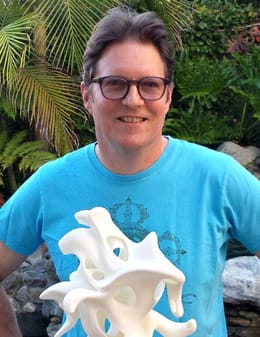About Kevin Mack

Kevin Mack is an artist and Academy Award winning visual effects pioneer. Kevin received the Oscar for Best Visual Effects for his work on What Dreams May Come. Kevin Mack filmography
Kevin's work is inspired by transcendent visions, technology, and natural phenomena, and is informed by research in a wide range of fields from neuroscience to artificial life. Among the first to exploit the unique capabilities of 3D printing, Mack produces sculptural forms that cannot be achieved by any other means. Kevin's 3D printed sculptures and other art can be seen at KevinMackArt.com
Kevin created Shape Space to realize his lifelong dream of sharing his artistic visions as immersive virtual reality art experiences. Kevin brings decades of exceptional creative and technological innovation on his mission to create new dimensions of imagination and wonder for virtual reality.
The son of Disney artists, Kevin grew up drawing, painting and sculpting. In high school, he studied classical guitar and started experimenting with audio synthesis. Kevin attended Art Center College of Design, where he majored in Fine Art, Illustration and Film. After college, Mack supported his experimental art and music working in the film industry doing traditional matte painting, scenic painting, sculpture, model making, stop-motion animation, storyboards, concept art and set design for commercials and movies.
In the mid-eighties, Kevin began experimenting with computers to make art and music. Recognizing the computer's potential for film work, he helped pioneer the use of computer graphics for visual effects and became a creative leader in the development and application of digital art technologies. In 2007 he received an honorary Doctorate of Science degree from Art Center for his contributions to the field of motion picture visual effects.
Mack's work in artificial life and rule based systems, used to grow the CGI tree in WHAT DREAMS MAY COME, and the inside of a human brain in FIGHT CLUB, inspired the development of tissue simulation software that has been used for virtual stem cell research. In 2006, Mack received the title of Honorary Neuroscientist, from UCLA's David Geffen School of Medicine, for his lectures there on perception and visualization. In 2012, Kevin worked with physicists at CERN on the visualization of recent discoveries in particle physics. Since 2014, Mack has been focused on developing and sharing his Shape Space virtual reality artworks and speaking about virtual reality, art, and the future at related expos, conferences and events.
Kevin's work is inspired by transcendent visions, technology, and natural phenomena, and is informed by research in a wide range of fields from neuroscience to artificial life. Among the first to exploit the unique capabilities of 3D printing, Mack produces sculptural forms that cannot be achieved by any other means. Kevin's 3D printed sculptures and other art can be seen at KevinMackArt.com
Kevin created Shape Space to realize his lifelong dream of sharing his artistic visions as immersive virtual reality art experiences. Kevin brings decades of exceptional creative and technological innovation on his mission to create new dimensions of imagination and wonder for virtual reality.
The son of Disney artists, Kevin grew up drawing, painting and sculpting. In high school, he studied classical guitar and started experimenting with audio synthesis. Kevin attended Art Center College of Design, where he majored in Fine Art, Illustration and Film. After college, Mack supported his experimental art and music working in the film industry doing traditional matte painting, scenic painting, sculpture, model making, stop-motion animation, storyboards, concept art and set design for commercials and movies.
In the mid-eighties, Kevin began experimenting with computers to make art and music. Recognizing the computer's potential for film work, he helped pioneer the use of computer graphics for visual effects and became a creative leader in the development and application of digital art technologies. In 2007 he received an honorary Doctorate of Science degree from Art Center for his contributions to the field of motion picture visual effects.
Mack's work in artificial life and rule based systems, used to grow the CGI tree in WHAT DREAMS MAY COME, and the inside of a human brain in FIGHT CLUB, inspired the development of tissue simulation software that has been used for virtual stem cell research. In 2006, Mack received the title of Honorary Neuroscientist, from UCLA's David Geffen School of Medicine, for his lectures there on perception and visualization. In 2012, Kevin worked with physicists at CERN on the visualization of recent discoveries in particle physics. Since 2014, Mack has been focused on developing and sharing his Shape Space virtual reality artworks and speaking about virtual reality, art, and the future at related expos, conferences and events.

